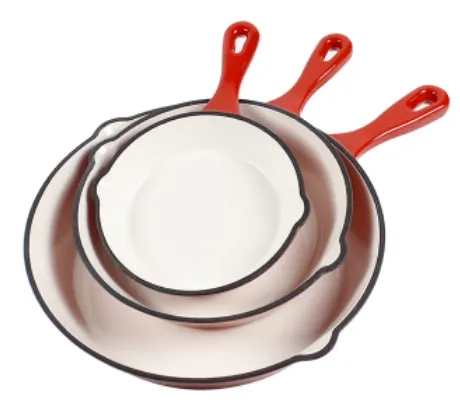The Science of Enameled Cast Iron Baking Pan
The culinary world has long revered cast iron baking pan for their unmatched heat retention and durability. However, the advent of enameled bakeware has revolutionized this timeless material, combining the robustness of cast iron with a sleek, non-reactive coating. For wholesalers and commercial kitchens, understanding the science behind enameled cast iron bakeware is key to appreciating its value in high-demand culinary environments. This article explores how the enamel coating transforms performance, durability, and versatility, making it a staple in professional and bulk culinary settings.

The Composition and Manufacturing Process of Enameled Bakeware
Enameled cast iron bakeware begins with the same foundation as traditional cast iron baking pan—a sand-cast iron core. The transformative element lies in the enamel coating, a fusion of powdered glass and pigments fired onto the iron at temperatures exceeding 1,400°F. This process creates a vitreous, non-porous surface that bonds chemically with the iron.
For wholesalers, this manufacturing method ensures consistency in large-scale production. Brands like Le Creuset and Staub use automated electrostatic spraying to apply enamel evenly, minimizing defects. The result is a uniform coating that resists chipping and cracking, even under repeated thermal stress—a critical factor for commercial kitchens that demand reliability.
Superior Heat Retention and Distribution in Enameled Bakeware
While traditional cast iron baking pan excel in heat retention, the enamel coating in enameled cast iron bakeware enhances this property. The glass-like layer prevents direct contact between food and iron, reducing hot spots and distributing heat more evenly. This is particularly advantageous for baking and braising, where consistent temperatures are essential.
In commercial settings, such as bakeries or catering services, this even heat distribution translates to uniform cooking results across large batches. For example, a hotel kitchen using enameled bakeware for sourdough loaves can achieve identical crusts and crumb structures in every batch, reducing waste and improving efficiency.
Non-Reactive Enameled Bakeware Cooking Surface: Expanding Culinary Versatility
One of the most significant wholesale advantages of enameled cast iron bakeware is its non-reactive surface. Traditional cast iron baking pan can leach iron into acidic dishes (e.g., tomato sauce) and require seasoning to prevent rust. The enamel coating eliminates these issues, allowing chefs to cook acidic, alkaline, or salty foods without metallic tastes or corrosion.
This versatility makes enameled bakeware ideal for diverse menus. A restaurant chain can use the same Dutch oven for simmering wine-braised short ribs and baking lemon-infused desserts, streamlining kitchen operations and reducing the need for multiple cookware types.
Durability and Low Maintenance in High-Volume Enameled Bakeware Settings
Commercial kitchens prioritize equipment that withstands heavy use. Enameled cast iron bakeware excels here, as the coating resists scratches, stains, and odors better than raw cast iron. Unlike traditional cast iron baking pan, which require regular seasoning, enameled versions need only basic cleaning—no oiling or special treatments.
For wholesalers, this durability reduces return rates and fosters long-term client relationships. A school cafeteria purchasing enameled bakeware in bulk benefits from decades of use with minimal upkeep, lowering total ownership costs.
Market Trends Driving Wholesale Demand for Enameled Bakeware
The shift toward versatile, high-performance cookware in hospitality has surged demand for enameled cast iron bakeware. Trends like artisanal baking, sous-vide cooking, and Instagram-worthy presentation favor enameled pieces for their aesthetic appeal and functionality. Wholesalers are also noting increased interest from meal-kit companies and ghost kitchens, which prioritize compact, multi-functional tools.
Additionally, sustainability trends boost enameled bakeware sales. Commercial buyers view its longevity as an eco-friendly alternative to disposable or short-lived cookware, aligning with corporate sustainability goals.
FAQ:Addressing Key Questions About Enameled Cast Iron Bakeware
How does enameled bakeware compare in cost to traditional cast iron for buyers?
While enameled cast iron bakeware has a higher upfront cost, its durability and low maintenance reduce long-term expenses.
Can enameled bakeware withstand commercial dishwashers?
Yes. Most commercial-grade enameled bakeware is dishwasher-safe, though handwashing is recommended to preserve the coating’s luster over decades.
Is enameled cast iron bakeware suitable for high-heat applications?
It withstands temperatures up to 500°F, making it oven-safe for most recipes. However, direct flame contact (e.g., induction stovetops) requires enameled pieces designed for stovetop use.
Do wholesalers offer customization for enameled bakeware?
Many manufacturers provide bulk customization, such as branded colors or handles, to align with a buyer’s kitchen aesthetics or corporate identity.
How does the environmental impact of enameled bakeware compare to traditional cast iron?
Both are highly sustainable due to longevity. However, enameled cast iron bakeware avoids the need for chemical seasonings, reducing environmental toxins over time.
For wholesalers and commercial kitchens, enameled cast iron bakeware represents a fusion of tradition and innovation. Its scientific advancements in heat management, durability, and versatility make it a smart investment for high-volume culinary operations. As demand grows for efficient, sustainable tools, this cookware is poised to remain a cornerstone of professional kitchens worldwide.
-
The Rise of the Big Cast Iron Griddle in Outdoor Cooking CultureAmakuruJun.09,2025
-
Multi-Use Magic of Cast Iron BBQ Grill PanAmakuruJun.09,2025
-
How a Meat Weight Press Enhances FlavorAmakuruJun.09,2025
-
Historical Roots of the Casserole Cast Iron PotAmakuruJun.09,2025
-
Essential Accessories for Mastering Dutch Oven CampingAmakuruJun.09,2025
-
Why Ecast Iron Grills Are Heating Up Outdoor CookingAmakuruMay.23,2025
-
Why Cast Iron Cookware Belongs in Every Kitchen?AmakuruMay.23,2025
